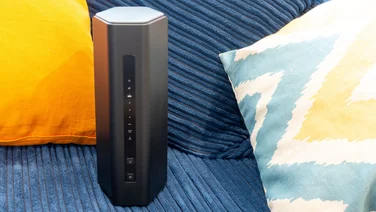To help us provide you with free impartial advice, we may earn a commission if you buy through links on our site. Learn more



- Excellent coverage
- Handy smart home hub
- Built-in antivirus and parental controls
- Relatively pricey
- Costly for what you get
- Expensive compared to other mesh systems
The TP-Link Deco M5 system has long been one of our favourites, offering strong whole-home performance at a competitive price. The new M9 Plus is quite a bit more expensive, but it brings upgraded wireless hardware, plus built-in Bluetooth and Zigbee hubs, so it can connect directly to compatible smart home devices like lightbulbs and sensors.
READ NEXT: The best wireless routers you can buy right now
TP-Link Deco M9 Plus review: What you need to know
The Deco M9 Plus is a tri-band 802.11ac mesh wireless system. It serves up a Wi-Fi network on both the 2.4GHz and 5GHz bands, while an additional 5GHz radio provides a dedicated backhaul for communications between Deco units. This means there’s much more bandwidth to go around than there was on the dual-band Deco M5, where a single 5GHz radio had to handle both client and backhaul traffic.
The standard Deco M9 Plus pack contains only two nodes, but TP-Link claims that these will cover the same area as three Deco M5 units – that is, 4,500 square feet, or around 420m2, which should be fine for a medium-sized, two-storey home.
Integrated smart home hub capabilities mean that as well as serving up Wi-Fi, each node can also connect directly to a wide range of IoT devices, and the Deco smartphone app lets you control all your disparate gadgets from a single interface.
TP-Link Deco M9 Plus review: Price and competition
At a launch price of £350, the Deco M9 Plus is the most expensive mesh networking system we’ve reviewed. Zyxel’s excellent Multy X system promises similar coverage for £100 less, while a three-pack of TP-Link’s own Deco M5 discs costs just £200. Alternatively, the three-node BT Whole Home Wi-Fi extender system can be yours for just £189.
Of course, the Deco M9 Plus scores over all those rivals with its built-in smart-home hub – and as we’ll discuss, performance is excellent too. Even so, you’re paying a big premium for those benefits.
TP-Link Deco M9 Plus review: Setup
The Deco M9 Plus units look almost identical to the Deco M5 ones. Since they’re designed to lie flat, their 144mm diameter takes up a bit more space on your shelf or worktop than an upright design such as the BT Whole Home Wi-Fi system, but they’re also less conspicuous, standing just 64mm high. This is probably a good thing, as they’re not exactly objets d’art; like their predecessors, they look more like smoke detectors than lifestyle accessories.
As usual with mesh gear, the Deco system is intended to plug directly into a broadband modem and replace your existing router. If that’s not an option – for example, if you’re using a combination modem/router with no modem-only mode – then you can switch it into Access Point mode and use the nodes as simple wireless extenders for your router. Just be aware that most of the Deco’s advanced features (including TP-Link’s signature security features, which we’ll come to below) aren’t available in this configuration.



Getting set up is a breeze. Once you’ve plugged in your first Deco node, you can use the smartphone app, available for Android and iOS, to quickly detect it and set a wireless network name and passphrase. I whizzed through this, and pairing the second node was then as simple as plugging it in, waiting for the single LED to show that it was ready to connect, then tapping the Connect button in the app.
TP-Link Deco M9 Plus review: Connections and features
Most home mesh units come with two Gigabit Ethernet ports, and that’s exactly what you’ll find tucked around the back of the each Deco M9 Plus node. Personally I don’t think this is enough, especially since one of the ports will be taken up by the connection to your modem, but if you want to attach more wired devices you can always invest in a cheap Ethernet switch.
Indeed, if you do have lots of wired devices, you’ll be glad to hear that the M9 Plus should be able to serve them a bit more speedily than many rival mesh systems, thanks to its clever ability to borrow spare bandwidth from the regular wireless network to boost the backhaul. Or, for the fastest possible connection, you can string an Ethernet cable directly between the nodes, which will then automatically switch to wired backhaul mode.
At the back of each unit you’ll also find a USB 2 port – but this is one of those tantalising connectors that’s “reserved” for some internal function. If you were hoping for an easy way to share files or stream videos over your mesh network, you’re out of luck.
Still, there’s a good spread of features accessible via the app. Those who like to get hands-on with their network settings can reserve IP addresses, set up port forwarding and even configure basic VLAN settings – assuming you’re using the system in router mode, of course. You can also optionally activate the 802.11r fast roaming protocol, to help ensure devices get seamlessly handed off between nodes as you move around, and connect to TP-Link’s own DDNS service to make your home network externally accessible. Basic Alexa support meanwhile allows Amazon Echo owners to use voice controls to adjust QoS and guest network settings.
The app also gives access to TP-Link’s “Homecare” security features, which include network-level protection against virus and hack attacks (courtesy of Trend Micro) and parental controls that let you enforce both time limits and category-based website filtering on a per-device basis. You get three years of service included in the price, although slightly discouragingly there’s no official word on how much it will cost to continue the service after that period expires.
Finally, the “smart home” section of the app offers a pretty sophisticated set of controls for supported IoT gadgets, from manufacturers including Philips, Samsung, OSRAM and (naturally) TP-Link itself. You can set up one-touch shortcuts to send specific commands to lights, locks, plugs, thermostats and other connected devices, and even create automated routines that link operations to schedules and actions – so, for example, you can specify that if you turn off the living room light between 8pm and 9am, the landing lights should go out as well.
TP-Link Deco M9 Plus review: Performance
As I’ve mentioned, the Deco M9 Plus has an extra radio compared to the M5, and it also boasts eight antennae packed into each little disc – twice as many as its predecessor. These should both translate to better performance, and in use I was certainly happy with the speed of the Deco M9 Plus kit. In my usual file-copy test, sending a folder full of 100MB files up and down over the wireless network, I measured same-room transfer speeds of a very creditable 24MB/sec – the best I’ve seen from any mesh system.
More importantly, the Deco system held up brilliantly when I ventured out of the living room to the more remote corners of my home. As I moved to the upstairs bedroom, my test laptop automatically switched its connection to the secondary Deco node that I’d positioned in the kitchen in the middle of the house, and once again I was able to enjoy excellent download speeds of 24MB/sec. Even in the bathroom at the rear of the house, where I normally get a flaky 1.6MB/sec connection from my regular router, the Deco network gave me a super-slick 19MB/sec.



Upstream speeds were predictably slower, since my laptop isn’t equipped with such a powerful transmitter, but I still got a nippy 11MB/sec upstream from the living room and 10MB/sec elsewhere.
So impressed was I by the Deco’s coverage that I decided to test whether the signal might even reach the outdoor terrace behind my home. Technically, the answer was yes, but the connection here was flaky, with an average download rate of 1.4MB/sec. Moving the second node to the rear of the house yielded a much smoother 4MB/sec, but now speeds in the bedroom and bathroom fell to 5MB/sec and 8MB/sec respectively.
In short, the two Deco M9 Plus nodes do a mighty impressive job of filling a medium-sized home with Wi-Fi, although if you want to cover the largest area you’ll have to live with an overall drop-off in performance.
READ NEXT: The best mesh Wi-Fi routers you can buy
TP-Link Deco M9 Plus review: Verdict
The Deco M9 Plus is the fastest mesh networking system I’ve tested – and with its built-in antivirus and smart-home controls, it’s also the most feature-packed. Such superlatives come at a hefty price, but for some it’ll be worth paying. Smart-home enthusiasts who’ve already splashed out hundreds on connected bulbs, sensors and appliances surely won’t baulk at paying for a system that brings them all so neatly together.
There’s also a definite value in the Deco’s built-in Homecare features: on some mesh systems, “parental controls” can mean something as basic as the ability to manually disconnect individual clients, and if website filtering is offered at all, it’s too often a blanket blacklist rather than something you can carefully tailor and target. However, if it’s the Deco M9 Plus’ security credentials that have turned your head, don’t forget that you can get the same features much more cheaply with the Deco M5 system, which now costs just £196 for a three-node pack.
And this, indeed, points to the reason why I can’t wholeheartedly recommend the Deco M9 Plus to everyone. For most of us there’s an alternative mesh system out there – perhaps the Zyxel Multy X or BT Whole Home Wi-Fi system – that will do a satisfactory job for a much lower price. The merits of TP-Link’s new mesh system are beyond question, but the price is so far from its rivals that it only makes sense if you really need this combination of top-notch performance and features.








